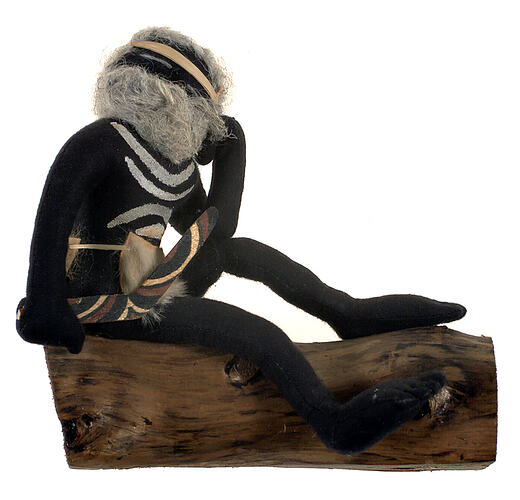Summary
Note: This object includes elements appropriated from First Peoples culture and heritage. Such cultural appropriation is not condoned by Museums Victoria which considers it to be inappropriate, even racist. Historical distance and context do not excuse or erase this fact.
Doll produced to represent a 'typical' Indigenous Australian person; it was given to Monica Gates, circa 1960s-1970s. The image of Indigenous Australians' painted and with a boomerang remains a common depiction of Indigenous Australians used by both Indigenous and non-Indigenous Australians for a variety of purposes. Boomerang's are also a common representation of Australian Indigenous cultural heritage and are often sold as souvenirs.
The Gates collection contains 170 national dolls from 74 different countries and some correspondence relating to the acquisition of several of the dolls. The costumes of the dolls represent national costumes from the 19th Century to the 1990s. Monica Gates collected or was given these dolls between 1957 and 1990.
These dolls were purchased as souvenirs of particular countries and like many mass produced souvenirs they are often not accurate representations of a particular country or region, and may actually better reflect neighbouring counties or regions. This occurs because costumes are often stylised and simplified resulting dolls wearing generic costume elements which are common to many countries/regions. Often the fabrics and decorations used are selected to make the dolls cheap and easy to manufacture and aesthetically pleasing. This can result in the fabrics, colours and decorations of the doll's clothing having little or no reflection of the costume associated with a particular country or region they are meant to be representative of.
Physical Description
Doll sitting on a wooden log and is made from material and wire. In his right hand the doll holds a painted boomerang and has white markings on his chest. This doll wears a fur covering and has grey curly hair and beard.
More Information
-
Collecting Areas
Clothing & Textiles, Childhood, Migration & Cultural Diversity
-
Acquisition Information
Purchase
-
Place Made
-
User
-
Other Association (See Comments)
Australia
Doll is representative of a common depiction of an Indigenous Australian person. -
Classification
-
Category
-
Discipline
-
Type of item
-
overall dimensions
15 cm (Length), 11 cm (Width), 15 cm (Height)
-
Keywords
Children's Play, Clothing, Cultural Awareness, Cultural Beliefs, Dolls, Indigenous Cultures, Indigenous Peoples, National Costumes, National Identity, Souvenirs
